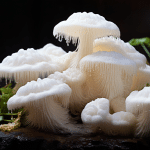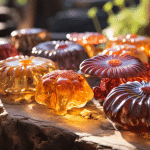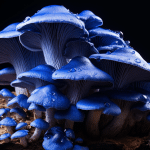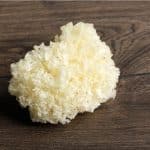For many, mushrooms appearing in their yard are mysterious, intriguing, and occasionally alarming, prompting questions of “why are mushrooms growing in my yard?”.
Beautiful, unique backyard mushrooms are intriguing, but some are poisonous, too, so it is always best to avoid touching or eating any unfamiliar wild mushrooms that pop up in your backyard.
But, the majority of common backyard mushrooms are harmless and have a major role to play in the ecosystem of your backyard. In this article, we will look at what backyard mushrooms are, why they are growing in your yard, and how to identify them.
What Mushrooms Grow In Your Backyard?
Backyard Mushrooms are fruiting bodies of underground fungi that live beneath your yards soil. These fungi are critical to breaking down woody organic materials in your soil, making it more productive. If your yard has mushrooms, this is generally a sign that your soil is healthy, and has plenty of organic material to support lawn, shrub, and tree growth.
Why Do Mushrooms Grow in Backyards?
Most of the time, the fungus in your yard stays buried beneath the ground, feeding off organic matter in your soil. They may remain dormant for years. But when conditions are right, they will produce the reproductive structures that we call mushrooms.
By that point, they are established under the surface, and a mushroom is just a signal that a mushroom is growing thriving in your yard. Mushrooms can grow so fast, that they will often appear overnight from nothing, popping up seemingly from nowhere.
Learn more: Organic medicinal mushrooms
If you have mushrooms growing in your yard, that means that conditions are right for underground fungi to replicate. The soil has sufficient food for the underground mycelium, and the temperature and humidity levels of the area are suitable for the mushroom to produce. An environment with lots of organic material: Buried wood, old tree stumps, fallen leaf litter, animal waste, and other decaying organic material are ideal for mushrooms. The more organic material you have in your yard, the more mushrooms-producing fungi you will get.
Wet, humid conditions: Mushrooms thrive in wet environments with high humidity levels, so they will often appear after heavy rainfalls. They are also often found in areas of the yard that are not well-drained or are moist. Shaded, protected, or protected spaces: Mushrooms tend to grow in shaded areas protected from the wind, or areas that have lots of mulch, leaves, or compost. If those conditions are present in your backyard, chances are good that you will get some backyard mushrooms.
The 7 Common Backyard Mushrooms
Wild mushrooms growing in forests and grasslands differ greatly from country to country. But when visiting gardens across North America, you often will find some of the same familiar mushrooms growing in your own back yard. And mycologists have noticed it is a worldwide phenomenon. So, while the types of mushrooms differ between countries, there are some common species that flourish around the world in gardens that are in a temperate climate.
Learn more: Adaptogenic mushroom powder
1. Ringless Honey Mushroom (Armillaria Tabescens)
The Ringless Honey Mushroom is in the same family as a honey mushroom, both are fairly common in urban yards during the late summer and fall. Both have a dry, honey-colored cap over a long stalk, which is usually fused at the base. The only noticeable difference between them is that ringless honey mushrooms have no rings on their stems.
These mushrooms grow in clusters on tree bases or stumps, usually in very large numbers. They sometimes appear to grow from the ground, but actually grow from roots or other wood that is submerged.
Honey mushrooms are edible, but you should always prepare them before eating. Even after they are cooked, some people still get cramps, nausea, and upset stomach. The non-ringed yam mushrooms have a few toxic, and even deadly, appearances. So a knowledgeable forager should confirm their identity if you are planning to eat them.
2. Field or Meadow Mushroom (Agaricus Campestris)
Field or Meadow Mushrooms are amongst the most widely eaten wild mushrooms in the UK and Ireland. It is closely related to the common button mushroom, with similar flavors and textures. You will find these growing by themselves or in groups, arcs, or in gradually expanding rings called fairy rings, in fields, grasslands, and meadows.
Their caps are cream-white, 1-4 inches (3-10 cm) across. The caps edges typically stay downward-turned or rolled inwards, even after the mushrooms are fully grown. When cutting into the caps, the flesh should be dense and white, occasionally turning a little pink, but never turning yellow.
Like Portobellos, their gills begin with deep pink, turning brown, eventually turning black as the mushrooms grow. There are different species of mushrooms you can mistake for field mushrooms, some are also edible, while others are toxic.
3. Common Stinkhorn (Phallus Impudicus)
The Common Stinkhorn is one member of a family of several different stinkhorns, known for their foul-smelling smells and their phallic form when they are mature. They are found commonly throughout the UK, Ireland, Europe, and North America during summer through the end of fall. You find them growing in forests and in mulch gardens, which have lots of woody organic material.
When the stinkhorns come out, an aromatic olive-green cap covers the blob, and holds its spores. They emit a powerful smell described as like that of decaying flesh, which attracts insects, which spread out the spores. Despite the odor, they are generally non-poisonous.
In some countries, people eat the immature stinkhorns, called “eggs” due to their egg-like appearance. Their scent really appeals to pets, and reports of young dogs getting really sick after eating adult stinkhorns exist.
4. Mower’s Mushrooms (Panaeolus Foenisecii)
Mower Mushrooms, also called Haymaker Mushrooms or Brown Hay Mushrooms, are prevalent on turf lawns throughout North America and Europe during the summer months. These small, brown mushrooms have caps 0.4-1.2 inches (1-3 cm) across, ranging in color from brown or orange-brown to a lighter beige depending on how moist they are. Mower mushrooms are not edible, but they are not very toxic, which is a good thing because these are some mushrooms children often eat. But, some that look similar are highly toxic, and it is not easy to tell apart small, brown mushrooms. So, removing any from your yard is probably best, if you have children or pets.
5. Shaggy Ink Cap (Coprinus Comatus)
The shaggy inkcap, also called shaggy mane or attorneys wig, is another mushroom often found in back yards. They first appear as white cylindrical bodies emerging from the ground, and then the cap, which is bell-shaped and covered in scales, opens. When this mushroom is ready to spore, its gills expel a smoky black fluid filled with spores, which drips onto the ground.
What makes shaggy-headed caps more remarkable is that within hours of the spores being released, they are darkened and dissolving. The same happens when you scoop them up. The fuzzy, unkempt caps are edible when young, but you have to pick them fast before they become a gooey mess. Something to keep in mind is that certain mushrooms from the same family as the shaggy ink caps are bad for mixing alcohol, and if consumed with alcohol, produce mild poison.
6. Fairy Ring Mushroom (Marasmius Oreades)
Also known as fairy-ringed champignons or Scotch Bonnets, fairy-ringed mushrooms are quite common. They grow on lawns and parks across North America, Europe, the UK, and Ireland. Fairy-ring mushrooms grow in progressively expanding rings on lawns.
They have a spherical cap that is 0.8-2 inches (2-5 cm) wide, pale brown, and wrinkly or ridged on the edges. Their gills are free from the stem and are white, turning a pale tan or cream color when the mushrooms are ripe.
The fungus is edible and has a sweet flavor, and is commonly used in soups, sauces, and stews. Be cautious in identifying these, because similar toxic mushrooms exist.
7. Giant Puffball (Calvatia Gigantea)
The giant puffball (Calvatia Gigantea) grows throughout North America and other temperate regions around the world, and it can get enormously large. It can grow as wide as 8-24 inches (20-60 cm) wide and as tall as 3-12 inches (7.5-30 cm).
Unlike other mushrooms, the puffball grows like solid balls with no gills, caps, or stem. While some folks are fortunate to get gigantic puffballs in their yard, smaller species of puffballs, measuring as little as 2 inches (5 centimeters), are among the most common mushrooms found in the back yard. There are several different species of puffballs, all edible when young and still white inside. Correctly identifying young puffball mushrooms before eating is vital, because some toxic amanita mushrooms resemble puffballs in their early growth stages.
To make sure you are getting the correct mushrooms, slice the suspected puffballs in half. The flesh inside should be thick, firm, and solidly white. If there is a shape, gills, or any coloration of black, brown, yellow, or purple in the interior, throw out the mushroom.















